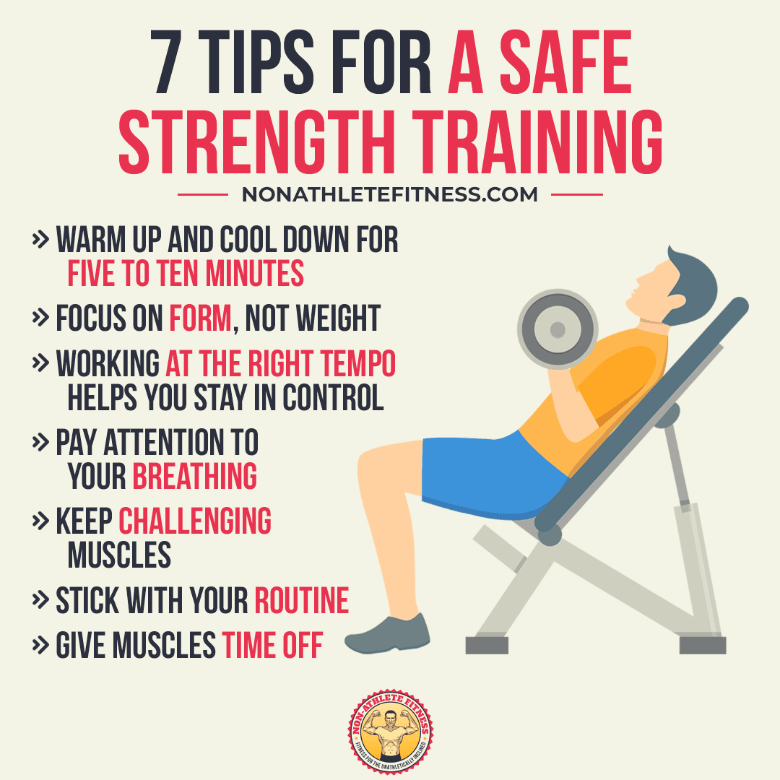If you’ve never set foot in a gym before, or are still new to working out in general, it’s important to keep safety in mind as you put your body through movements or a degree of stress it is not accustomed to.
Working out safely is critical to avoiding injury and derailing your progress before you even get started.
Here are 7 tips for a safe strength training session you’ll want to keep in mind to train safely.

1. Warm Up/Cool Down
Never let yourself jump into a routine without having warmed up.
It doesn’t matter if you’ve been performing a certain routine for years.
Without a proper warmup, you risk hurting yourself in different ways, such as pulling a muscle.
When your workout is winding down, you need to cool down, where you keep up your routine but at a rate that’s not a dramatic downshift.
The Car Analogy
Think of using your body like you’re driving a car.
Not warming up would be like pressing on the gas before the engine is fully ignited.
Meanwhile, not cooling down would be like ending your rides by slamming on the brakes and pulling the emergency brake.
You’re going to end up with a pretty poor-performing car if you keep that up.
Similarly, warming up and cooling down lets you perform at your peak whenever possible.
Your muscles and joints can stretch more, you get more blood flowing, allowing for greater endurance, and you can recover much more quickly.
All great athletes you see, winning gold medals and scoring winning points, can likely tell you about how much warming up and cooling down has helped them.
2. Focus on Form
One rep with proper form is infinitely better than 10 reps with improper form.
Every time you pick up a weight or prepare to use a machine, you need to focus on form. There needs to be a fluid form that you follow with every rep.
Review form by reading step-by-step instructions and watching others.
Videos from bodybuilders can show you how to safely control your movements.
Follow along with these without weights so your body can be prepared for the actual routine.
Don’t Get Sloppy
When you’re used to something, it can be tempting to not pay as much attention to what you’re doing.
To bring it back to cars, it’s why people will get into accidents due to careless errors after years of driving.
You need to make sure you’re always following proper form when strength training, no matter what.

3. Control Your Rep Tempo
Tempo isn’t just for musicians.
Athletes need to have a good rhythm in order to keep their endurance up.
It’s why you don’t see marathon runners start sprinting right out the gate.
Your strength training is a different situation, but the rules of consistent tempo are still present.
Count It Out
For each rep, count to a certain number, depending on the routine.
You might be able to count to five for dumbbell curls but need more time for bench presses.
Don’t cheat on these counts by rushing. If necessary, you might need to count “one-Mississippi” for each number.
If you really want to get in a rhythm, try using a metronome.
There are metronome apps that let you set the tempo.
This way, you can let the beat guide you, helping you make your reps at least somewhat uniform.
4. Pay Attention to Breathing
Being so focused on your performance that you forget proper breathing is a major risk factor when you’re strength training.
It might seem cool and tough to be caught up like that, holding your breath until you’re near the point of collapse.
However, you’re only sabotaging your performance and putting your safety at risk by doing that.
Breathing is a manual process in many cases.
But when you’re working out, you need to be conscious of your breathing and adjust whenever it’s been affected.
Know the Right Way
How you breathe is as important as breathing.
You should be breathing fully through your diaphragm, not shallowly through your mouth.
It’s also important to breathe out when you’re raising the weight and in when you’re releasing it.
I initially did it the other way around. Whenever I get ready to strength train now, I rehearse exhaling and inhaling.
I also keep myself from expending my breath by understanding when to stop.
If it’s difficult for me to take a full breath, or I know that I won’t be able to breathe as comfortably as I need to for my next rep, I stop.
Sometimes, I need a few minutes to gather my breath.
Other times, I need to call it a day.
A proper cool down is an excellent way for me to get my breathing back to a comfortable level.
5. Keep Up the Challenge
Whenever you’re strength training, you need to think about what you can do to improve upon the previous session.
If you’re not pushing yourself at least some, then you’re going to hit a ceiling.
Be careful about not doing more than you’re able to handle, but don’t just loiter around your comfort zone longer than you have to.
Set Your Goals
If your only goal is to get bigger to lift more weight, you’re going to feel the frustration of no direction.
Attach numbers to your goals, starting with ones you can reach.
Maybe you want to be able to lift 100 pounds in two months. You can break this down further with shorter-term goals, like lifting 50 pounds in a month’s time.
Be realistic about your goals, but don’t go too easy on yourself.
Even with warming up, cooling down, and proper form, you might have some muscle soreness.
That’s your body working itself into the strong entity you know it can be.
Moments like these aren’t as rewarding as showing off your gains on social media, but they’re just as important.
6. Stick To Your Routine
This is the most important part of any routine, exercise, or otherwise, and it’s the one that people have the hardest time with.
In order to get results from strength training, you have to do it regularly.
There are no healthy shortcuts, and the sooner you cut through your excuse generator and focus on your routine, the better things can be for you.
“But I don’t want to spend my life at the gym”
That’s good to hear. You’ll be happy to know that you can get strong without turning into a total gym rat.
Strength training benefits aren’t just for Mr. Universe contenders.
You could just do 30 minutes a day and see some serious results after just a couple of months.
If you’re going to protest that you don’t have that much time available, then try for 20 or maybe 10 minutes per day.
Still don’t have enough time?
Then, you need to think about why you’re interested in strength training if it’s going to be so hard for you to do the minimum: showing up.
Your brain may not feel comfortable with this change in routine, but it’s easier to trick than you realize.
Start off by pledging to exercise for only two minutes at a time.
There’s no way you can’t find at least two minutes.
Set a timer and when it goes off, see just how far you’ve gotten. The best-case scenario is that you’ve locked into a groove and you go much longer.
The worst-case scenario is that you stop there and end up with only two minutes worth of exercise.
Hey, it’s always going to be better than nothing.

7. Give Muscles Time Off
You shouldn’t let yourself get exhausted and then go beyond your threshold when you’re exercising without taking proper precautions or knowing what you are doing.
The image of the insatiable bodybuilder who lifts as their capillaries burst is anything but inspiring.
All bodies, no matter how strong they might appear, are made to take at least some kind of break.
Otherwise, work you’re doing to help your body could actually end up hurting it.
The Importance of Breaks
You need to take rests between sets and between workouts. You’re relying on your body’s energy to fuel these routines, and sources of energy, such as food and water.
However, this type of energy isn’t an endlessly renewable resource.
You have to give yourself time and opportunities for it to be replenished.
When you’re just starting out, it might not be hard to take a day or two off so your muscles can recover.
However, when you start to become more comfortable with working out, you might need to make a point of reminding yourself to rest.
If you’re eager to be active and know you can do at least something, focus on cross-training by addressing different parts of your body on different days.
You might have worked your shoulders pretty hard one day, but another day could be good for your legs.
Take a longer break if you’ve been dealing with certain pain or an injury.
Don’t let yourself take unnecessarily prolonged breaks.
The longer you put it off, the more difficult it will be to go back to normal.
Summary
Did you ever think there was so much to keep in mind with strength training?
A lot of this is fairly common sense, but it’s all important. It’s common sense to wear a seatbelt when you’re in a vehicle, but that doesn’t prevent people from skipping that too.
One area we didn’t get to cover but which is incredibly crucial is your attitude. You need to have a proper attitude when you’re picking up and sticking to a routine.
Go into it with positive expectations and intentions.
Check yourself if you sense you’re doing this for petty reasons, such as trying to make yourself look tough or if you’re rushing into things so that you can try to get buff as soon as possible.
That’s a great way to end up looking like a total washout and ultimately ditching this in favor of something that feels rewarding without requiring effort.
But this effort doesn’t have to be anything that puts you through hell.
Sure, it’s going to be a little different and kind of uncomfortable at first, but what worthwhile thing in life isn’t exactly that?
You have to take chances to see success.
Along with that, you also need to be careful and not put yourself in harm’s way.
Responsibility matters, and it’s what’s going to keep you safe and focused on what you’re doing, not on what others are doing.
If you follow these seven tips and keep up the proper mindset, you can become stronger than ever, both physically and mentally.



